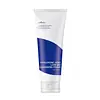What's inside
What's inside
 Key Ingredients
Key Ingredients

 Benefits
Benefits

 Concerns
Concerns

 Ingredients Side-by-side
Ingredients Side-by-side

Water
Skin ConditioningSodium Cocoyl Isethionate
CleansingGlycerin
HumectantSodium Methyl Cocoyl Taurate
CleansingGlycol Distearate
EmollientPotassium Cocoate
EmulsifyingPotassium Cocoyl Glycinate
Caprylyl/Capryl Glucoside
CleansingSodium Hyaluronate
HumectantHydrolyzed Hyaluronic Acid
HumectantHydroxypropyltrimonium Hyaluronate
Sodium Hyaluronate Crosspolymer
HumectantHyaluronic Acid
HumectantSodium Acetylated Hyaluronate
HumectantHydrolyzed Sodium Hyaluronate
Skin ConditioningPotassium Hyaluronate
Skin ConditioningButylene Glycol
HumectantEclipta Prostrata Leaf Extract
Skin ConditioningLaminaria Japonica Extract
Skin ProtectingAmaranthus Caudatus Seed Extract
Skin ConditioningCentella Asiatica Extract
CleansingFicus Carica Fruit Extract
HumectantUlmus Davidiana Root Extract
Skin Conditioning1,2-Hexanediol
Skin ConditioningGlycine
BufferingSerine
MaskingGlutamic Acid
HumectantAspartic Acid
MaskingLeucine
Skin ConditioningAlanine
MaskingArginine
MaskingLysine
Skin ConditioningIsoleucine
Skin ConditioningPhenylalanine
MaskingProline
Skin ConditioningThreonine
Tyrosine
MaskingValine
MaskingHistidine
HumectantCysteine
AntioxidantMethionine
Skin ConditioningDipotassium Glycyrrhizate
HumectantBeta-Glucan
Skin ConditioningPanthenol
Skin ConditioningCeramide NP
Skin ConditioningHydrogenated Lecithin
EmulsifyingFructooligosaccharides
HumectantAllantoin
Skin ConditioningOryza Sativa Bran Extract
Skin ConditioningPentylene Glycol
Skin ConditioningSodium Chloride
MaskingHydroxyacetophenone
AntioxidantCitric Acid
BufferingDisodium EDTA
Polyquaternium-39
Decylene Glycol
Skin ConditioningEthylhexylglycerin
Skin ConditioningWater, Sodium Cocoyl Isethionate, Glycerin, Sodium Methyl Cocoyl Taurate, Glycol Distearate, Potassium Cocoate, Potassium Cocoyl Glycinate, Caprylyl/Capryl Glucoside, Sodium Hyaluronate, Hydrolyzed Hyaluronic Acid, Hydroxypropyltrimonium Hyaluronate, Sodium Hyaluronate Crosspolymer, Hyaluronic Acid, Sodium Acetylated Hyaluronate, Hydrolyzed Sodium Hyaluronate, Potassium Hyaluronate, Butylene Glycol, Eclipta Prostrata Leaf Extract, Laminaria Japonica Extract, Amaranthus Caudatus Seed Extract, Centella Asiatica Extract, Ficus Carica Fruit Extract, Ulmus Davidiana Root Extract, 1,2-Hexanediol, Glycine, Serine, Glutamic Acid, Aspartic Acid, Leucine, Alanine, Arginine, Lysine, Isoleucine, Phenylalanine, Proline, Threonine, Tyrosine, Valine, Histidine, Cysteine, Methionine, Dipotassium Glycyrrhizate, Beta-Glucan, Panthenol, Ceramide NP, Hydrogenated Lecithin, Fructooligosaccharides, Allantoin, Oryza Sativa Bran Extract, Pentylene Glycol, Sodium Chloride, Hydroxyacetophenone, Citric Acid, Disodium EDTA, Polyquaternium-39, Decylene Glycol, Ethylhexylglycerin
Water
Skin ConditioningGlycerin
HumectantSodium Laureth Sulfate
CleansingCoco-Glucoside
CleansingCoco-Betaine
CleansingSucrose Cocoate
EmulsifyingPolyglyceryl-4 Caprate
EmulsifyingPEG-120 Methyl Glucose Trioleate
CleansingPhenoxyethanol
PreservativeGlyceryl Oleate
EmollientSodium Chloride
MaskingCitric Acid
BufferingEthylhexylglycerin
Skin ConditioningSodium Benzoate
MaskingPropanediol
SolventHydrogenated Palm Glycerides Citrate
EmollientLecithin
EmollientAscorbyl Palmitate
AntioxidantTocopherol
AntioxidantParfum
MaskingLinalool
PerfumingWater, Glycerin, Sodium Laureth Sulfate, Coco-Glucoside, Coco-Betaine, Sucrose Cocoate, Polyglyceryl-4 Caprate, PEG-120 Methyl Glucose Trioleate, Phenoxyethanol, Glyceryl Oleate, Sodium Chloride, Citric Acid, Ethylhexylglycerin, Sodium Benzoate, Propanediol, Hydrogenated Palm Glycerides Citrate, Lecithin, Ascorbyl Palmitate, Tocopherol, Parfum, Linalool
 Reviews
Reviews

Ingredients Explained
These ingredients are found in both products.
Ingredients higher up in an ingredient list are typically present in a larger amount.
Citric Acid is an alpha hydroxy acid (AHA) naturally found in citrus fruits like oranges, lemons, and limes.
Like other AHAs, citric acid can exfoliate skin by breaking down the bonds that hold dead skin cells together. This helps reveal smoother and brighter skin underneath.
However, this exfoliating effect only happens at high concentrations (20%) which can be hard to find in cosmetic products.
Due to this, citric acid is usually included in small amounts as a pH adjuster. This helps keep products slightly more acidic and compatible with skin's natural pH.
In skincare formulas, citric acid can:
While it can provide some skin benefits, research shows lactic acid and glycolic acid are generally more effective and less irritating exfoliants.
Most citric acid used in skincare today is made by fermenting sugars (usually from molasses). This synthetic version is identical to the natural citrus form but easier to stabilize and use in formulations.
Read more about some other popular AHA's here:
Learn more about Citric AcidEthylhexylglycerin (we can't pronounce this either) is commonly used as a preservative and skin softener. It is derived from glyceryl.
You might see Ethylhexylglycerin often paired with other preservatives such as phenoxyethanol. Ethylhexylglycerin has been found to increase the effectiveness of these other preservatives.
Glycerin is already naturally found in your skin. It helps moisturize and protect your skin.
A study from 2016 found glycerin to be more effective as a humectant than AHAs and hyaluronic acid.
As a humectant, it helps the skin stay hydrated by pulling moisture to your skin. The low molecular weight of glycerin allows it to pull moisture into the deeper layers of your skin.
Hydrated skin improves your skin barrier; Your skin barrier helps protect against irritants and bacteria.
Glycerin has also been found to have antimicrobial and antiviral properties. Due to these properties, glycerin is often used in wound and burn treatments.
In cosmetics, glycerin is usually derived from plants such as soybean or palm. However, it can also be sourced from animals, such as tallow or animal fat.
This ingredient is organic, colorless, odorless, and non-toxic.
Glycerin is the name for this ingredient in American English. British English uses Glycerol/Glycerine.
Learn more about GlycerinChances are, you eat sodium chloride every day. Sodium Chloride is also known as table salt.
This ingredient has many purposes in skincare: thickener, emulsifier, and exfoliator.
You'll most likely find this ingredient in cleansers where it is used to create a gel-like texture. As an emulsifier, it also prevents ingredients from separating.
There is much debate on whether this ingredient is comedogenic. The short answer - comedogenic ratings don't tell the whole story. Learn more about comegodenic ratings here.
The concensus about this ingredient causing acne seems to be divided. Research is needed to understand if this ingredient does cause acne.
Scrubs may use salt as the primary exfoliating ingredient.
Learn more about Sodium ChlorideWater. It's the most common cosmetic ingredient of all. You'll usually see it at the top of ingredient lists, meaning that it makes up the largest part of the product.
So why is it so popular? Water most often acts as a solvent - this means that it helps dissolve other ingredients into the formulation.
You'll also recognize water as that liquid we all need to stay alive. If you see this, drink a glass of water. Stay hydrated!
Learn more about Water